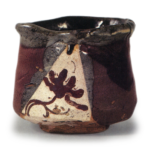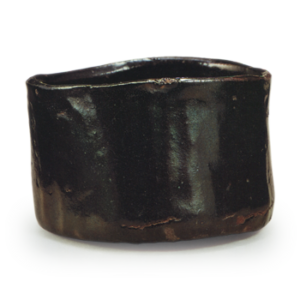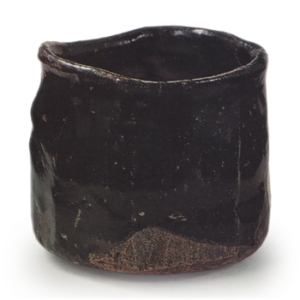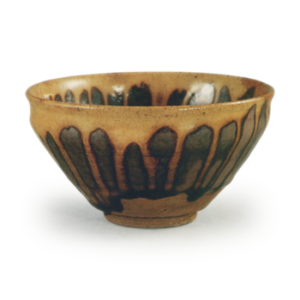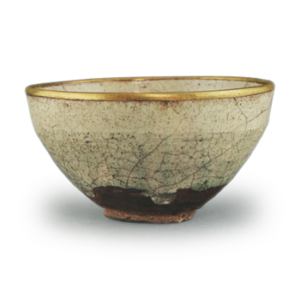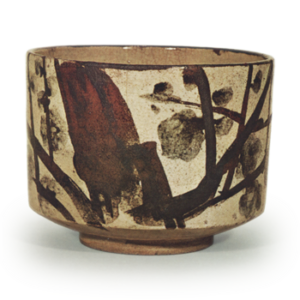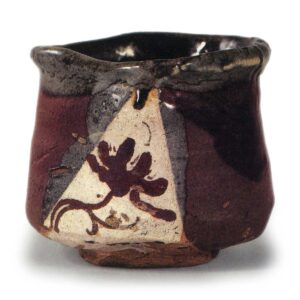
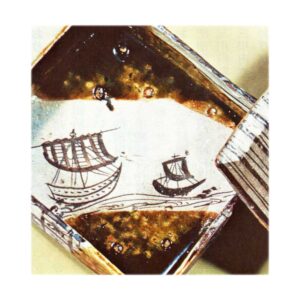
Oribe-yaki is a ceramic ware produced by Seto ceramic kilns and favored by the tea master Furuta Oribe-masa. Oribe-yaki is a name for only a part of the original Oribe ware, and the original Oribe ware includes the so-called Shino ware, which became the mainstream of Seto ware in the Azuchi-Momoyama period. It is said that Oribe ware’s heyday was one of the most glorious historical periods in the history of Seto art. In the “Chawan Chajiri-Merisho (Tea Bowl and Tea Container Book),” there are four types of Oribe ware: Oribe, Shino, Narumi, Seto, and E-note. Oribe-yaki in the narrower sense of the term is as shown below. Oribe ware in the narrower sense of the term is a new product that has evolved from the simple decorative techniques and shapes of traditional Kizeto and Shino ware, and has sought more complex effects through the use of color glazes, patterns, and shapes.
The shapes are generally distorted and unusual, and the polygonal forms are often extremely eccentric. The colors varied widely, including black, dark green, and red, and these colored glazes were applied mainly by the technique of tinting. When dyeing copper-green glaze, for example, white clay was used in the areas where the copper-green glaze was dyed to clarify the color of the glaze, and red clay was used in the areas where the glaze was colorless, thus creating a single vessel by joining two types of clay. Later, people mistakenly called this copper-green glaze “Oribe glaze,” and those with the entire glaze colored green were called “Oribe. The patterns varied widely, with some being close to a sketch style, while others had an exotic or geometric design. Most Oribe ware is fired by oxidizing iron, and although it is difficult to determine the degree of fire, it is slightly lower than that of Kizeto and Shino ware. Today, Oribe ware is mainly used for tea bowls, mukozuke (tea utensils), plates, bowls, and tokkuri (Japanese tea utensils). The mold making technique is not found in Kiseto and Shino, but was widely used in Oribe ware. Oribe shards were excavated from the kiln site at Kushiri Motoyashiki, Mino (Kushiri, Izumi-cho, Toki-shi, Gifu Prefecture), which was the first of the Karatsu-style climbing kilns introduced to Owari and Mino, and dates from the early Keicho period (1596-1615), but not later than the middle of that period. Oribe ware was produced in the nearby areas of Otomi, Ohira, Ohakase, Hime, and Akazu Shinano in Owari, and flourished from Keicho to Kan’ei (1624-44). However, the quality of the pottery was not as good as that of the walls because it was fired using oxidized iron, the decorations were too varied and showy, and the shapes were too eccentric to be of practical use. One hundred and forty years later, around the time of the Tenmei Era (1781-19), Oribe ware was again actively produced in Seto-Kitajima. Unlike the early Mino ware, the Oribe ware produced here had chrysanthemum patterns painted in dots on various parts of the blue-green glaze, and many of them were decorated with inka designs or pasted decoration and were entirely covered with blue-green glaze. However, Oribe ware was once again supplanted by the dye-glaze technique. Oribe ware was again supplanted by the rise of Sometsuke (blue-and-green glaze), but Shuntai in Akatsu at the end of the Edo period is famous for his active imitation of Oribe ware in the Mino style.
Oribe ware is also known as “black Oribe” or “Oribe black. The most common type of bowl is a tea bowl, and almost all of them are shoe-shaped. The overall black color is due to the iron glaze, which is obtained by drawing out the iron hook during firing and immediately placing the bowl in water to cool rapidly, a type of drawer black. The production is not very solid, and for this reason, most of the works are limited to matcha bowls. Many of them are decorated with simple floral designs in various arrangements. The “Yamamichi” tea bowls are black with white irregular string-like lines. See “Setoguro” and “Hikide Kuro.
Blue Oribe] Oribe ware nowadays mainly refers to blue Oribe.
Oribe ware nowadays mainly refers to blue Oribe. Copper-green glaze is often applied as a weeping glaze, or as a single-body glaze. The use of two different types of clay as a base for the one-sided glaze has been mentioned earlier. In this case, a pattern is drawn in iron sand on one half of the surface and a thin white glaze is applied. Many katamono have a cloth pattern. The cloth is covered to make it easier to separate from the mold. This cloth is also a decorative element. Many of the so-called total oribe pieces have underglaze line engravings or sealed flower patterns.
Aka Oribe: The white part of Ao Oribe is red and can be said to be a type of Ao Oribe. This red color is caused by the acid fire firing of iron contained in the clay. The red base clay was painted with white clay and then covered with iron sand, and the combination of white clay and iron sand was used to create a more complex decorative effect. This type of pottery is especially popular for items with cloth patterns.
E-ORIBE: Oribe patterns were applied with iron sand, reddish brown, or copper-green pigments. The shapes are generally odd and the patterns are also unique. The clay is white or red.
Oribe Sometsuke” is the name given to patterns painted on red clay using a combination of white clay, iron sand, and other paints.
Narumi Oribe: Ware made in Narumi, Owari Province (Narumi-machi, Midori-ku, Nagoya City). The “Chawaniki Bengokushu” (Tea Utensils Bengokushu) says, “There is a splendid tea caddy made of thin clay, light yellow and thinly made.
Karatsu Oribe: This is said to have been made by Furuta Oribe in Karatsu. It is difficult to determine the origin of this bowl because of its rarity, but it is reminiscent of Shino ware.

